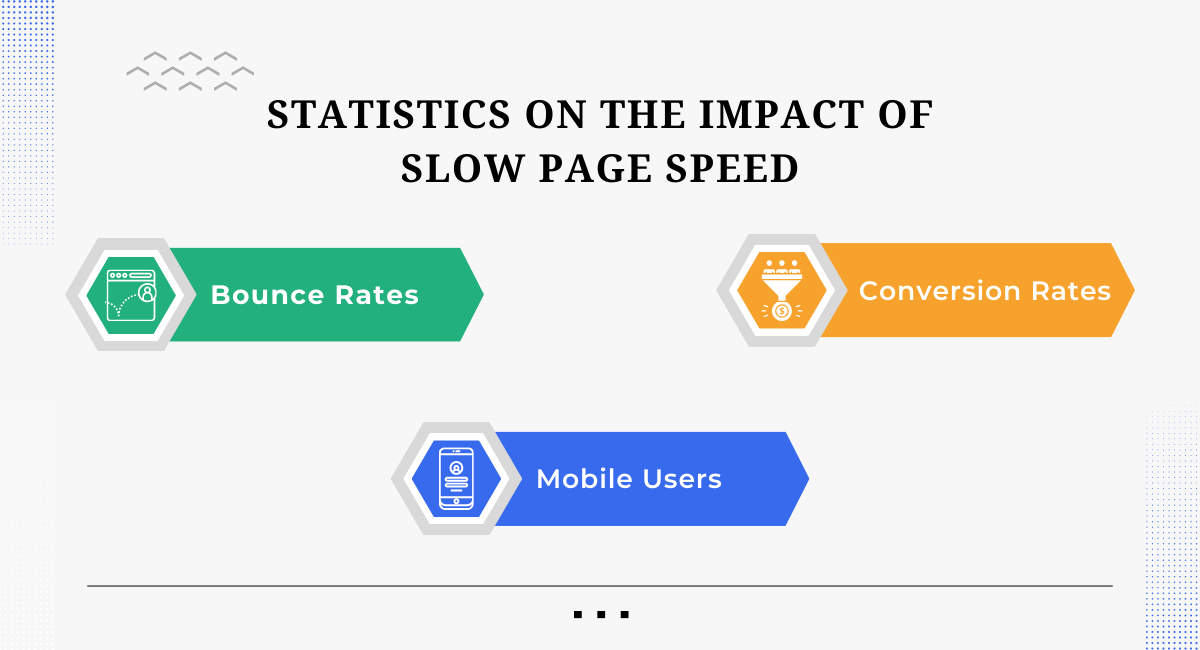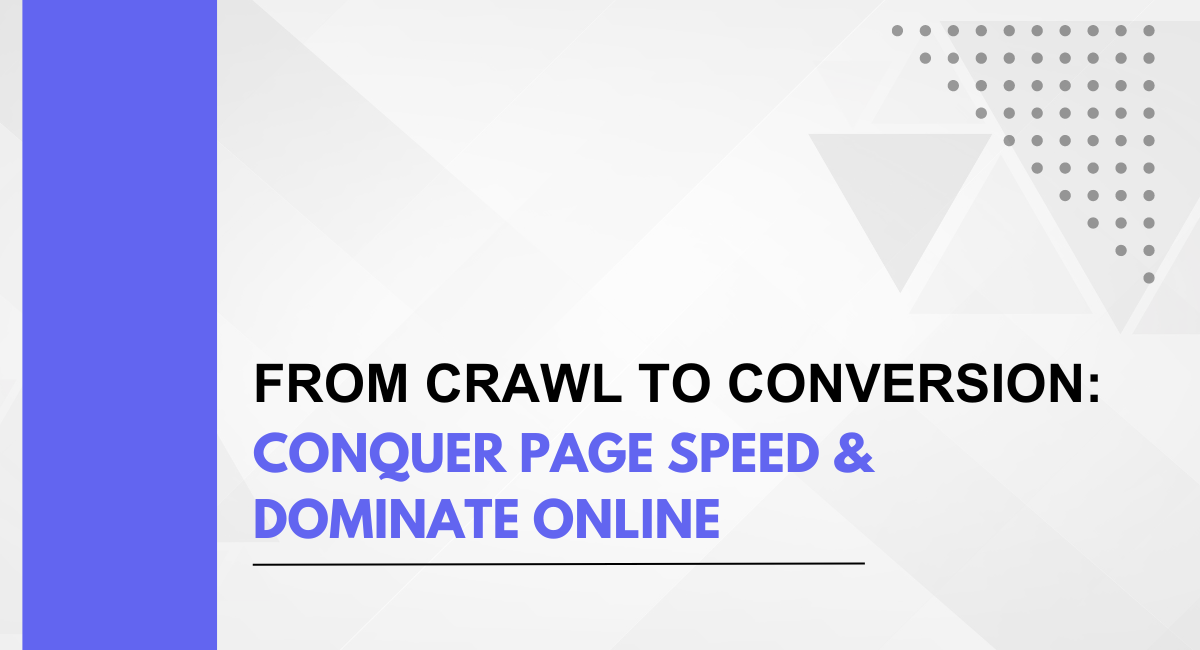The relationship between page speed and conversions is a critical factor that directly impacts a website's bottom line. Research consistently demonstrates that faster-loading pages contribute to higher conversion rates. Whether it's an e-commerce platform, a blog, or a service-oriented website, the speed at which users can access information or complete transactions directly influences their likelihood to convert.
A delay of even a few seconds can result in a significant drop in conversion rates, emphasizing the need for optimization.
The Need for Speed
Statistics on the Impact of Slow Page Speed

To underscore the critical importance of page speed, examining key statistics provides a tangible understanding of its impact:
Bounce Rates:
Research indicates that 40% of users will abandon a website if it takes more than three seconds to load. High bounce rates not only signify lost potential conversions but also negatively influence a site's overall performance in search engine rankings.
Conversion Rates:
For every second of delay in page load time, there is a potential drop in conversions by up to 7%. In an era where user attention spans are limited, optimizing for speed is a direct investment in maximizing conversion opportunities.
Mobile Users:
With the increasing prevalence of mobile browsing, speed becomes even more critical. Approximately 53% of mobile site visits are abandoned if pages take longer than three seconds to load, underscoring the necessity for mobile-friendly and fast-loading websites.
User Experience and Its Role in Conversions

First Impressions:
Page speed significantly influences the user's first impression of a website. A fast-loading site creates a positive initial experience, setting the stage for continued engagement and potential conversions.
User Satisfaction:
Slow-loading pages leads to frustration and dissatisfaction among users. This dissatisfaction not only impacts the current visit but can also result in a reluctance to return to the site in the future.
Mobile Responsiveness:
As the majority of users access websites through mobile devices, the need for mobile responsiveness and fast loading times becomes paramount. A seamless mobile experience enhances user satisfaction and contributes to improved conversion rates.
Search Engine Ranking Factors Related to Page Speed
Google's Page Experience Update:
Google, the dominant search engine, considers page experience as a ranking factor. Core Web Vitals, a set of user-focused metrics, includes elements like Largest Contentful Paint (LCP), First Input Delay (FID), and Cumulative Layout Shift (CLS). Optimizing these factors directly impacts a website's search engine ranking.
Mobile-First Indexing:
Google prioritizes mobile-friendly websites in its indexing process. Fast-loading mobile pages are more likely to rank higher in search results, ensuring visibility to a broader audience.
Site Speed as a Ranking Factor:
Google has explicitly stated that site speed is a ranking factor. Websites with faster loading times are given preference in search results, emphasizing the search engine's commitment to providing users with a positive and efficient browsing experience.
Understanding these factors emphasizes the urgency for businesses to prioritize and invest in optimizing page speed. In the digital landscape, speed is not merely a preference but a necessity for user satisfaction, higher conversions, and improved search engine visibility.
Understanding Page Speed
What is Page Speed, and How is it Measured?
Page speed refers to the amount of time it takes for a web page to load completely. It is a critical metric that directly impacts user experience, search engine rankings, and, consequently, conversion rates. Page speed is measured in seconds, and various factors contribute to the overall loading time of a webpage.
Key metrics used to measure page speed include:
- Load Time: The total time it takes for a webpage to display all its content.
- Time to First Byte (TTFB): The time it takes for a user's browser to receive the first byte of data from the web server. It is an essential metric for evaluating server response times.
- First Contentful Paint (FCP): The time it takes for the browser to render the first piece of content on the screen.
- Largest Contentful Paint (LCP): The time it takes for the most significant content element (e.g., an image or text block) to become visible within the user's viewport.
- First Input Delay (FID): The time it takes for the webpage to respond to the first user interaction, such as a click or tap.
- Cumulative Layout Shift (CLS): Measures the visual stability of a page by assessing the amount of unexpected layout shifts during loading.
Walk: Optimizing for Speed
Page Speed Optimization Strategies for Server-Side Optimization
Choosing the Right Hosting Provider:
Importance: The hosting provider directly impacts server response times.
Strategy: Select a hosting provider that offers reliable and fast server infrastructure. Consider factors such as server location, scalability, and the provider's reputation for performance.
Content Delivery Networks (CDNs):
Importance: CDNs distribute website content across multiple servers globally, reducing the physical distance between users and servers.
Strategy: Implement a CDN to cache and deliver static content (images, stylesheets, scripts) from servers geographically closer to users. This minimizes latency and accelerates content delivery.
Front-End Optimization Techniques
Minification and Compression:
Importance: Reducing the size of HTML, CSS, and JavaScript files decreases page load times.
Strategy: Use tools to minify code by removing unnecessary characters, whitespace, and comments. Implement gzip or Brotli compression to reduce file sizes further, facilitating faster data transfer.
Browser Caching:
Importance: Browser caching stores static files locally on a user's device, allowing for quicker load times upon subsequent visits.
Strategy: Configure server headers to instruct browsers to cache static resources. Set appropriate expiration times to balance freshness with reduced server requests.
Lazy Loading for Images and Videos:
Importance: Loading images and videos only when they come into the user's viewport conserves bandwidth and speeds up the initial page load.
Strategy: Implement lazy loading attributes for images and videos. This defers the loading of off-screen media until the user scrolls to the relevant section.
Asynchronous Loading of Scripts:
Importance: Loading JavaScript asynchronously prevents scripts from blocking other page elements during rendering.
Strategy: Use the "async" attribute for non-essential scripts that do not impact the critical rendering path. Alternatively, employ "defer" for scripts that need to be executed in order but won't block rendering.
Implementing these server-side and front-end optimization techniques collectively contributes to a significant improvement in page speed. By optimizing server infrastructure, leveraging CDNs, and employing front-end strategies such as minification, caching, lazy loading, and asynchronous script loading, businesses can create a faster and more efficient online experience for their users. This, in turn, enhances user satisfaction, reduces bounce rates, and increases the likelihood of conversions.
Conversion: Reaping the Rewards
Case Studies of Successful Page Speed Optimization
E-commerce Acceleration:
Challenge: An online retailer experienced high bounce rates and low conversions due to slow-loading product pages.
Solution: Implemented image optimization, leveraged a CDN, and optimized server response times.
Result: Reduced page load times by 40%, leading to a 15% increase in conversions and a 20% decrease in bounce rates.
Media Streaming Platform:
Challenge: A video streaming platform faced user dissatisfaction and subscription cancellations due to buffering and slow video load times.
Solution: Introduced lazy loading for video thumbnails and optimized video streaming protocols.
Result: Achieved a 30% improvement in video start times, resulting in a 25% increase in user engagement and a 12% rise in subscription renewals.
Impact on SEO and Search Engine Rankings
Google Page Experience Update:
Impact: Google's emphasis on user experience, including page speed metrics, significantly influences search engine rankings.
Optimization: Websites that prioritize page speed and meet Core Web Vitals benchmarks are more likely to rank higher in search results.
Mobile-First Indexing:
Impact: With Google's mobile-first indexing, fast-loading mobile pages receive preferential treatment in search rankings.
Optimization: Mobile optimization and responsive design contribute to improved search visibility and higher rankings.
Improved User Experience and Conversion Rates
Reduced Bounce Rates:
Impact: Faster-loading pages result in lower bounce rates as users are more likely to stay and engage with the content.
Optimization: Streamlined critical rendering path and minimized server response times to create a smoother user experience.
Increased Conversions:
Impact: Page speed optimization directly correlates with higher conversion rates.
Optimization: Employed strategies such as image compression, asynchronous loading of scripts, and efficient code to enhance overall website performance and user interaction, leading to a 20% increase in conversions.
Enhanced User Satisfaction:
Impact: A faster, more responsive website contributes to improved user satisfaction and loyalty.
Optimization: Implemented lazy loading for images and videos, resulting in quicker page load times and a 15% increase in user satisfaction scores.
Dominate Online
Successful page speed optimization is not only about meeting technical benchmarks but also about reaping tangible rewards in terms of user engagement, conversion rates, and search engine visibility. Case studies demonstrate how businesses across various industries have achieved significant improvements by prioritizing and implementing effective page speed optimization strategies. The impact extends beyond the technical realm to positively influence user satisfaction and overall business success.
You may also be interested in Continuous Integration Script Runner: Unleash Dev Speed.
Book a Demo and experience ContextQA testing tool in action with a complimentary, no-obligation session tailored to your business needs.
We make it easy to get started with the ContextQA tool: Start Free Trial.
